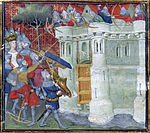Castle Park, Bristol

Castle Park (sometimes referred to as Castle Green) is a public open space in Bristol, England, managed by Bristol City Council. It is bounded by the Floating Harbour and Castle Street to the south, Lower Castle Street to the east, and Broad Weir, Newgate and Wine Street to the north. Its western boundary is less obviously defined and has been the subject of controversy, perhaps because the area around High Street and St Mary le Port Church, though not part of the park and always intended for development, is often considered at the same time as the park.Opened on 30 September 1978, the park occupies the site of what was once Bristol's main shopping district. The area was largely destroyed by the Luftwaffe during the Blitz, and that which remained was subsequently demolished by 1969, the last demolitions being the Bear & Rugged Staff and the Cat and Wheel pubs in Little Peter Street. In the years since the end of the Second World War, Castle Park has become home to a number of anti-fascist memorials. The ruined 14th century tower of St Mary-le-Port Church stands to the west of the park, surrounded by derelict financial office buildings. Adjoining the ruins of St Peter's Church in the middle of the park is a sensory herb garden on the site of the former St Peters Churchyard cleared 1965, and five silver birch trees as a memorial to the beaches of the D-Day landings. To the east is a grassy arena covering Castle Green and the west half of Castle Street, and the partially excavated remains of the great stone keep Bristol Castle with 2 preserved vaulted chambers formerly in Castle Green (Tower Street) farther east. There is also a bandstand. Tree-lined St Peter's Square, to the north of St Peter's Church, (formerly Dolphin Street, Peter Street and Church or Chequer Lane) has been home to various events including German Christmas markets. In recent summers a tethered balloon was placed near the bandstand, offering ascents to sightseers. Recent attempts to develop the area between the park's western edge and High Street have proved controversial; Bristol City Council are keen to replace the derelict 1963/4 buildings with a mixed-use development to help reconnect the Old City to Broadmead and raise funds to improve the park; others would rather see the park extended to High Street.
Excerpt from the Wikipedia article Castle Park, Bristol (License: CC BY-SA 3.0, Authors, Images).Castle Park, Bristol
Newgate, Bristol Broadmead
Geographical coordinates (GPS) Address Nearby Places Show on map
Geographical coordinates (GPS)
| Latitude | Longitude |
|---|---|
| N 51.4558 ° | E -2.5881 ° |
Address
Bristol Castle
Newgate
BS1 3EH Bristol, Broadmead
England, United Kingdom
Open on Google Maps










